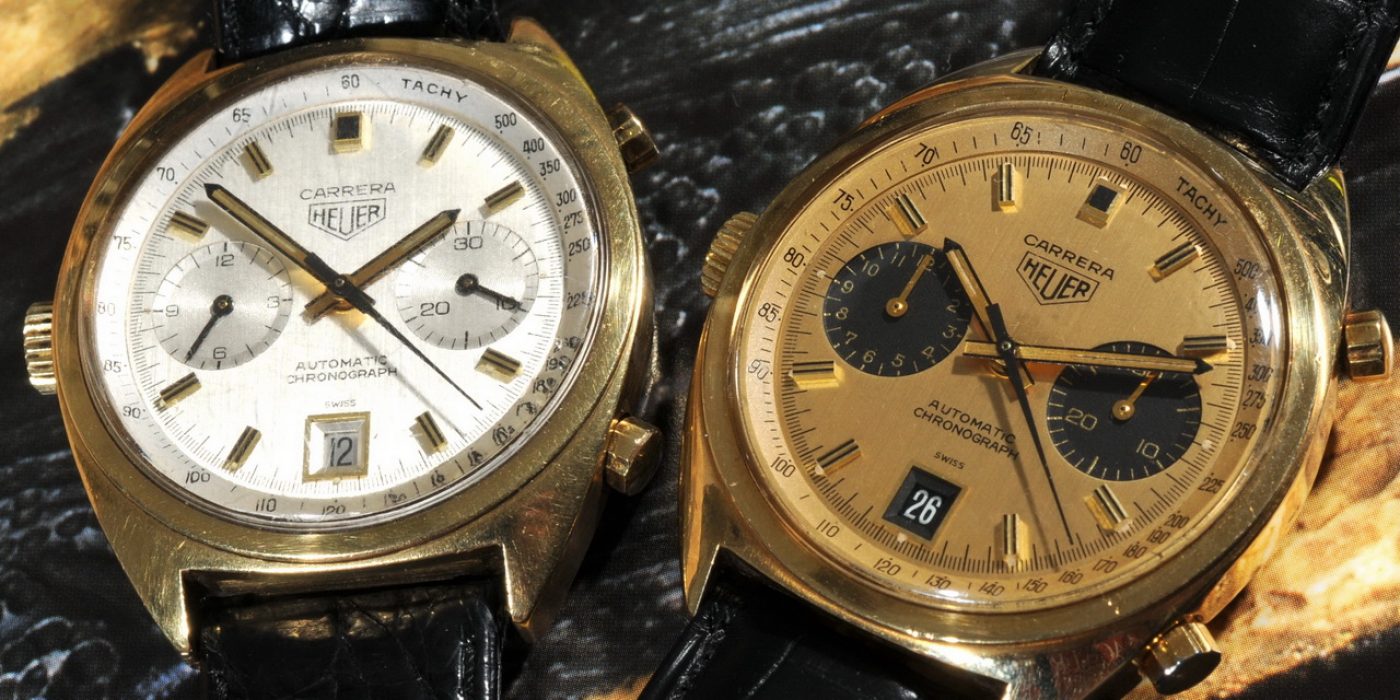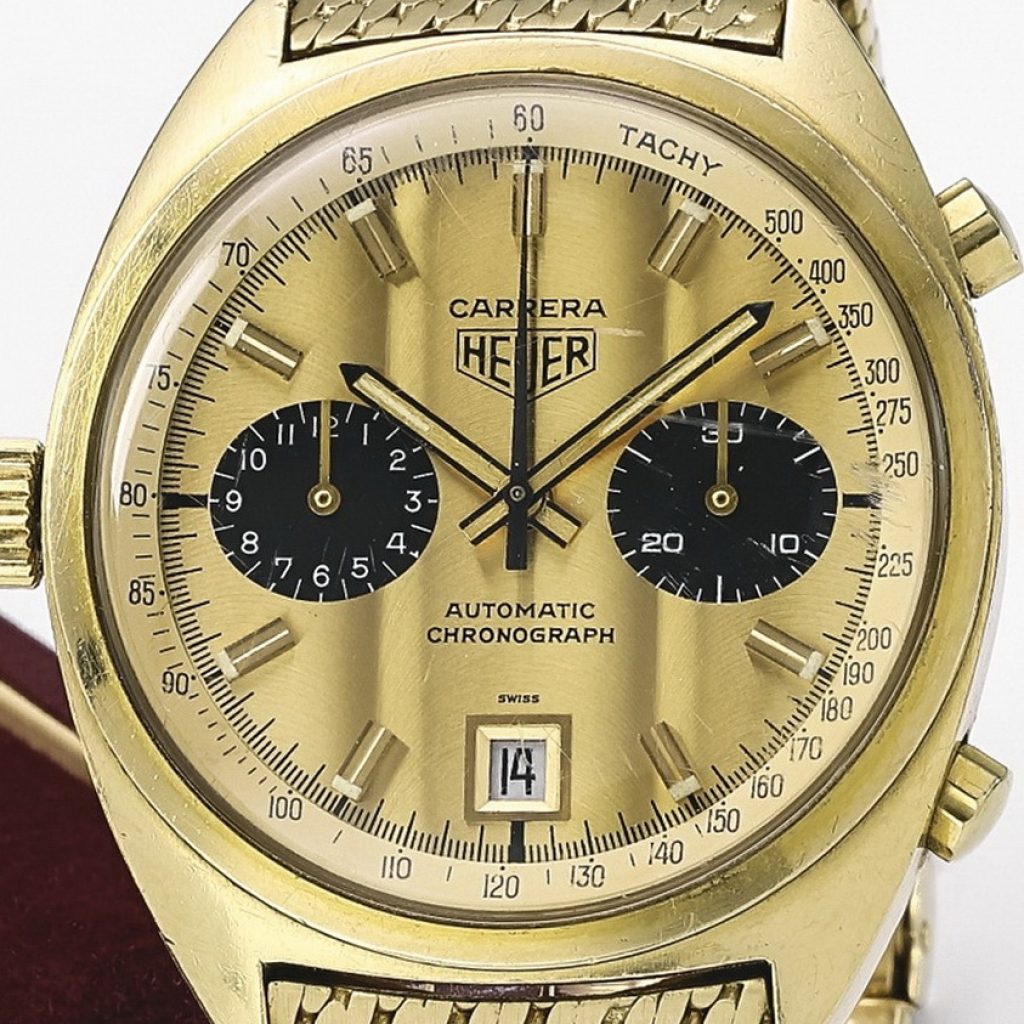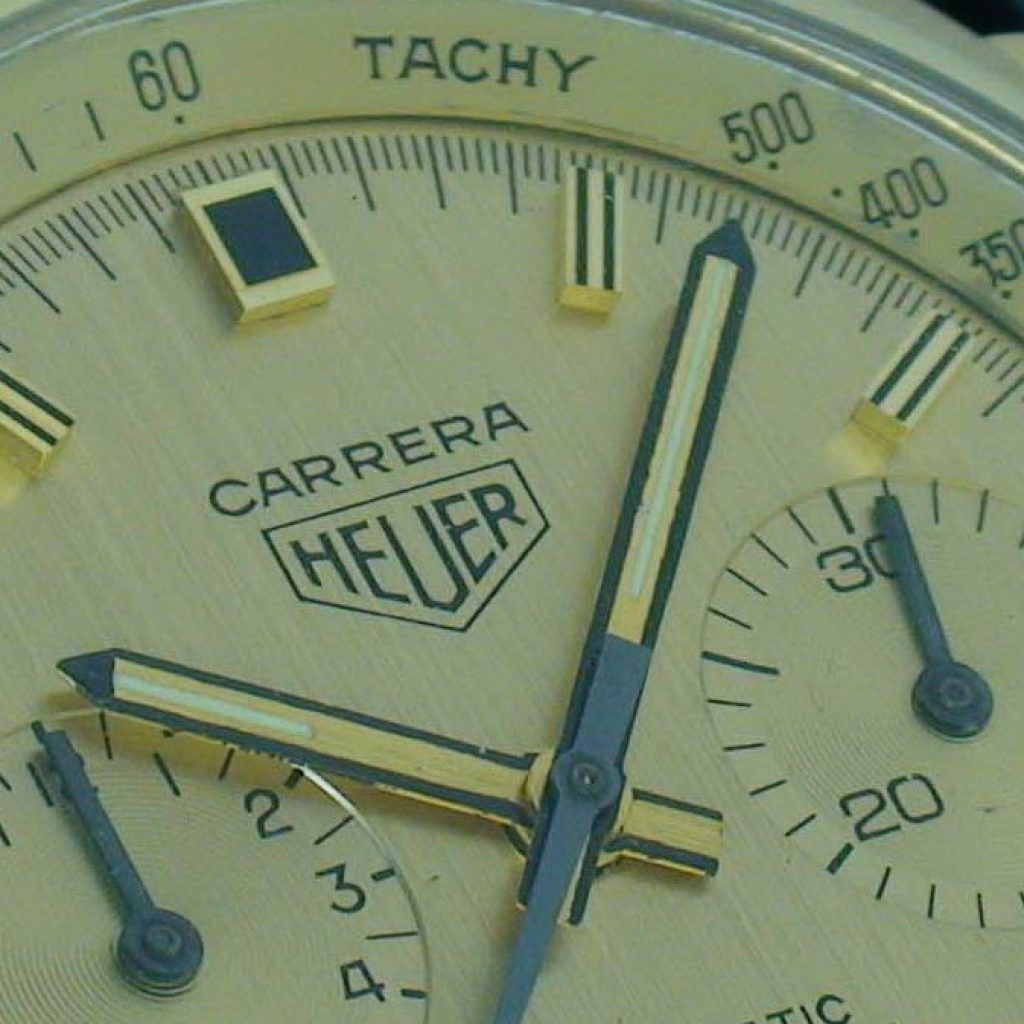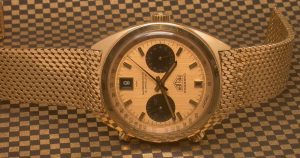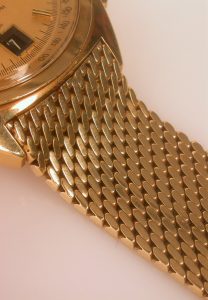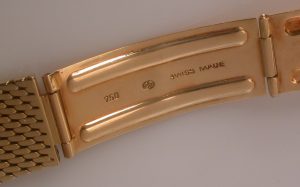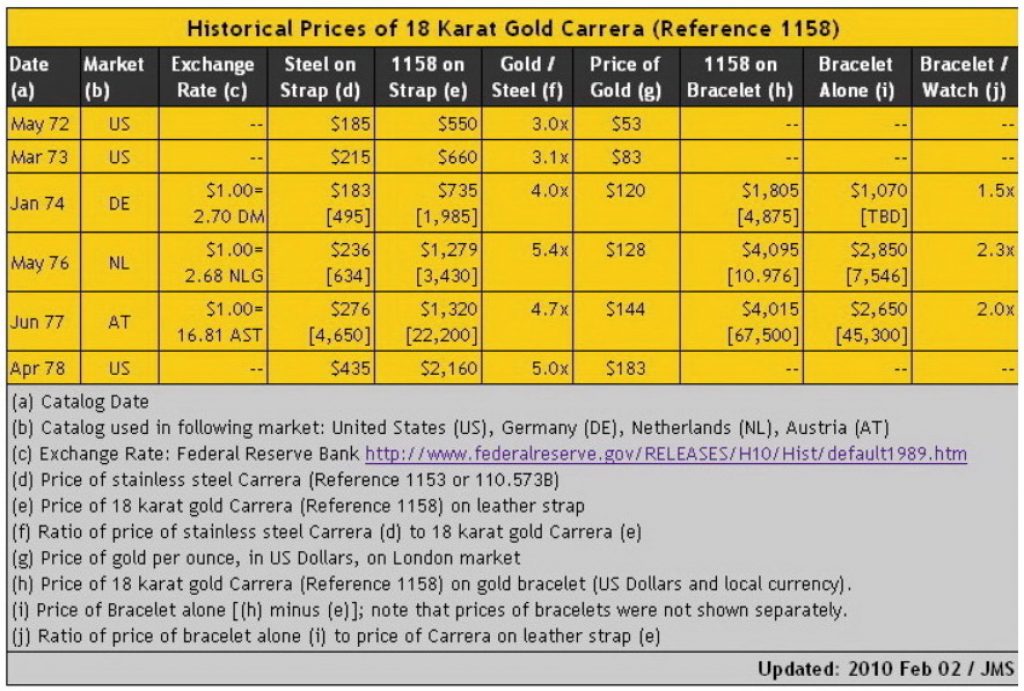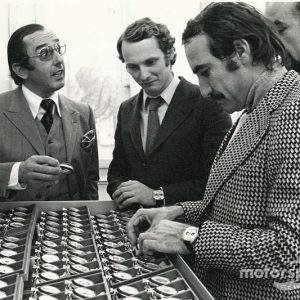The Carrera Reference 1158 is one of the most celebrated of the vintage Heuer chronographs. This is the model that Jack Heuer presented to the Ferrari Formula One drivers in the early 1970s, and the model is celebrated by today’s collectors. In this posting, we provide a guide to this highly-coveted Carrera.
The Reference 1158 Carrera was introduced in 1969 and production continued into the late 1970s, with the last appearance being in Heuer’s 1978 catalog.
Eight Standard Versions
There were eight versions of the 18 Karat Gold Automatic Carrera (Reference 1158), as follows:
Four versions of the 1158 S (silver dial):
1. “Chronomatic” version (from circa 1969) had “Chronomatic” across the top of the dial and “Carrera” across the bottom of the dial; first execution elements of the dial include (polished gold applied markers with black inserts, and numerals 3-6-9-12 on the hour recorder) and first execution hands (polished gold hands with black inserts); we believe that the Chronomatic version of the 1158 Carrera had extremely low production.
2. the first version (from circa 1970) had first execution dial (polished gold applied markers with black inserts, and numerals 3-6-9-12 on the hour recorder) and first execution hands (polished gold hands with black inserts); we believe that this version had extremely low production.
3. the second version had “transitional” dial (brushed gold applied markers, with gold at center and black edges, and numerals 3-6-9-12 on the hour recorder) and second exection hands (brushed gold, with black edges and points)
4. the third version (from circa 1972) had second execution dial (brushed gold applied markers, with gold at center and black edges, and numerals 1-through-12 on hour recorder) and second execution hands (brushed gold with black edges and points)
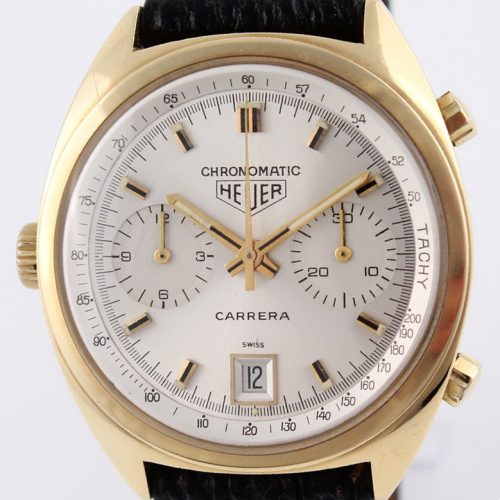
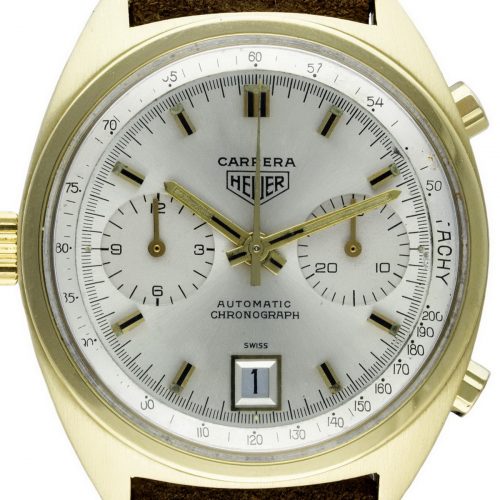
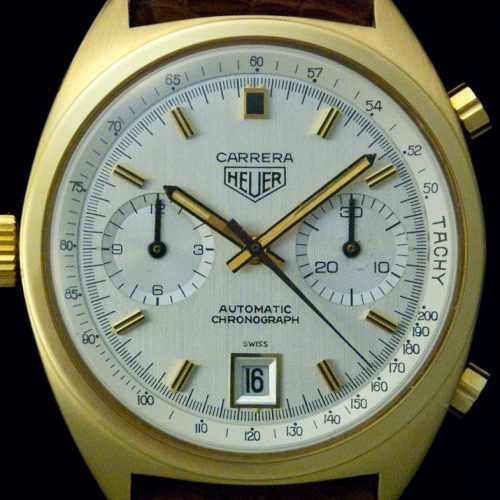
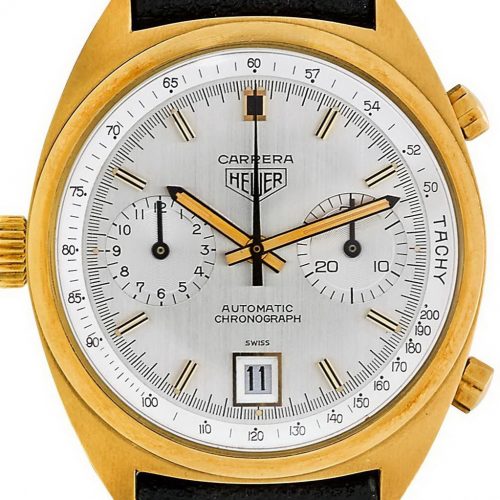
Two versions of the 1158 CH (champagne dial and registers):
1. the first version (from circa 1970) had second execution dial and first execution hands; note that we have never seen this execution “in the metal”, so it may be a prototype, it may be very low production, or it may be one that appeared in the catalog, but was never produced at all.
2. the second version (from circa 1974) had second execution dial and second execution hands
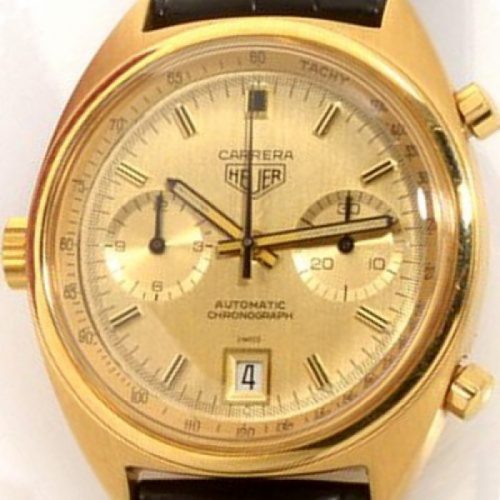
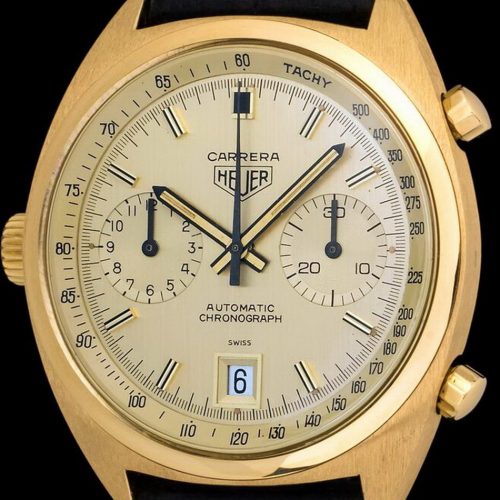
Two versions of the 1158 CHN (champagne dial / black registers):
1. the first version (from circa 1972) had second execution dial and second execution hands, with black date disc (and white numerals)
2. the second version (from circa 1977) had second execution dial and second execution hands, with white date disc (and black numerals)
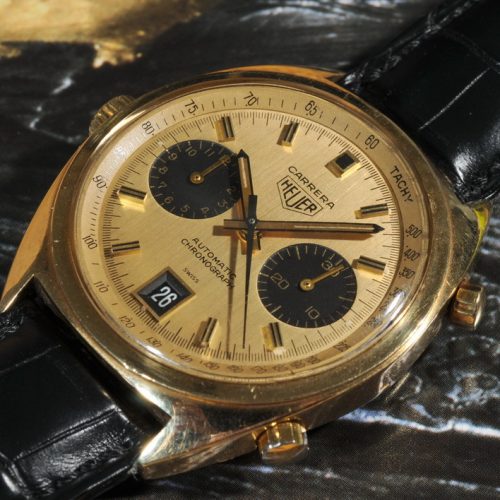
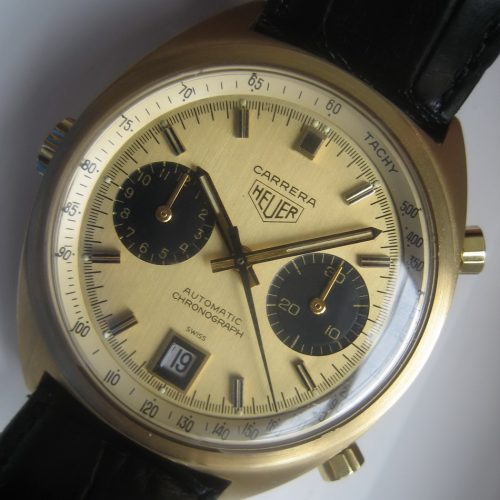
In addition to these eight standard production models of the Reference 1158 Carrera, there was one special model made by Heuer, as a gift for Formula One racer, Ronnie Peterson. This model used a Reference 1158 case, with a dial from the later Reference TBD model.
Defining Elements of the Carrera 1158 — Dial and Hands.
The photo below shows some of the defining elements of the 1158 Carreras.
This Carrera is an example of something that we see in so many of the Heuers — the hands match the markers, at least in a general sense. In this photo, we see the black edges of the hands matching up with the black edges of the markers. It’s the same concept in some of the steel automatic Carreras from the 1970’s . . . when the markers got fatter, then the hands got fatter.
These hands are difficult to photograph, but this photo shows the construction of the 1158 hands in good detail: brushed gold, with narrow luminous inserts, and black edges and black triangular tips.
These hands were used on all the production models of the 1158, once we get past the earliest models (from around 1970); the earlier models had polished gold hands, but these executions were either prototypes or very low production.
Notice the black inlay on the marker at twelve o’clock; these are the kinds of details that make these Reference 1158 Carreras so special.
Also notice the texture / grain on the dial. This brushed, metallic finish is similar to the finish we see on the Reference 1133 “transitional” Monacos.
The Bracelets
The bracelets for the 1158 Carreras are unique pieces within the line of Heuers, for several reasons. Today’s collectors might expect to find a Reference 1158 Carrera chronograph offered for sale three or four times per year; finding a bracelet is far more difficult.
Construction of These Bracelets. The bracelet is constructed in “Maglia Milanese” style, comprised of hundreds of small links of gold, assembled into a thick mesh. The longer piece of the bracelet (without the clasp) is 82 millimeters and has 32 diagonal rows of links, with 13 links per row; the shorter piece of the bracelet (which has the clasp) is 65 millimeters, without the clasp, and has 25 diagonal rows of links, with 13 links per row. The clasp is polished gold and stamped with the Heuer logo. One piece of the clasp is marked “750” (meaning 18 karat), “GF” (for Guy Frers, the manufacturer of the bracelet) and “Swiss Made”; the other piece of the clasp shows the date of production (by the quarter and year, for example 4/72). The bracelet is adjustable within the clasp, but the links may not be removed.
California Cool. Jack Heuer reports that the company did not consider the 18 karat gold bracelets to be consistent with Heuer’s sports / racing theme, but they thought of these massive gold bracelets as being more “California” / flashy style. [Remember that many people call chronographs “tool watches”; we do not see many 18 karat gold tools, do we?] Accordingly, when the US manager (in Springfield. New Jersey) requested that these gold bracelets be offered by Heuer, the company (in Switzerland) did not pursue the design and production of these bracelets, but this project was undertaken by the US manager, with the company’s approval. Mr. Heuer indiactes that any of the gold bracelets offered throughout the world probably came through the US office. It is interesting that, though these bracelets were not “officially” included in the company’s line of products, Heuer still showed the 1158s on the bracelets in most of its catalogs.
Why So Few Survivors? One of the mysteries of the vintage Heuer world is why there are so few survivors among the 18 karat gold bracelets for the Reference 1158 Carreras. Anaylzing the issue step-by-step, it becomes understandable: (1) There were very few of the chronographs made, and (2) even fewer of the bracelets made. (3) The bracelets were very long (accomodating a wrist of up to 8 inches), but (4) the only way to size the bracelet, other than the adjustment in the clasp, was to cut out a strip of the gold. So I suspect that (5) many of the folks who purchased these very expensive bracelets decided to remove the bracelets, and wear their watches on a nice leather strap, and (6) over the years, many of these precious bracelets have ended up abandoned in sock drawers or desk drawers, never to be reattached to the chronograph for which they were intended.
Gold Content
Gold Content of the Carrera 1158 and its Bracelet: The following table provides information relating to the weight of the Carrera 1158 and its 18 karat gold bracelet:
| total weight of watch and bracelet | 143 grams |
| weight of watch (head only) | 69 grams |
| weight of movement | 21 grams |
| weight of watch case (without movement) | 48 grams |
| weight of bracelet (both sections) | 73 grams |
| bottom section of bracelet (with clasp) | 40 grams |
| top section of bracelet | 33 grams |
| total weight of gold in watch and bracelet | 121 grams |
| ratio of gold in bracelet to gold in watch | 1.5-to-1.0 |
Below, we discuss the relative prices of the Carrera 1158 watch and the 18 karat gold bracelet, and we see that the bracelet cost approximately 1.5 times as the watch istself. The fact that the watch contains 48 grams of gold while the bracelet contains 73 grams of gold explains this pricing.
Prices of the Reference 1158 Carreras.
The 18 karat gold automatic Carreras were — far and away — the most expensive chronographs that Heuer ever offered. Because of the high price, few dealers kept them in stock, and they were “special order” items.
The following table provides information about the prices of the Reference 1158 Carreras, and their special bracelets, as shown in various catalogs over the period from May 1972 through April 1978. This table shows us that the 18 karat gold Carreras sold in a range between 3.0 and 5.4 times the price of the steel Carreras, and that the special bracelets for the 18 karat gold Carreras sold for between 1.5 and 2.3 times the price of the watch itself (on a leather strap). For example, in May 1976, we see that the steel Carrera sold for $236, while the 18 karat gold Carrera sold for $1,279 (on a strap), and the 18 karat gold bracelet for the Carrera sold for approximately $2,850. The Carrera with the bracelet sold for over $4,000.
Production Numbers.
According to a brochure published by TAG-Heuer in 2004, to mark the 40th anniversary of the Carrera, the 18 karat gold Carreras were produced in a limited series, comprised of 150 timepieces. This relatively low number has been the subject of some debate among modern-day collectors, with some collectors concluding that suggesting that — in view of the number of samples that we see today — the number produced in the 1970s must have been higher than 150.
The Formula One / Ferrari Connection.
The story of Heuer’s connection with racers and racing has been told many times: Jack Heuer went to the United States in the early 1960s, and in order to sell the company’s stopwatches, he began hanging out with the racing crowd (for example, attending events for the Sports Car Club of America). The big breakthroughs for Heuer came some years later, however, when Steve McQueen wore a Heuer Monaco in the movie, Le Mans, and when Heuer established an affiliation with the Ferrari racing team.
The Ferrari Team. The Heuer brand took center stage in automobile racing in the 1970s, evidenced by the brand’s affiliation with the Ferrari factory racing team (Scuderia Ferrari). From 1971 through 1979, Heuer provided timekeeping equipment for the Ferraru racing team. As part of the contractual relationship, each Ferrari race car — both in Formula One and in endurance racing — proudly displayed the distinctive Heuer logo.
The Ferrari Drivers. Just as Heuer had the deal with the Ferrari racing team, under which the team displayed the Heuer logo in exchange for Heuer timing equipment, Heuer had a parallel arrangement with each of the Ferrari Formula One drivers from the period from 1971 through 1979. Each of the Ferrari drivers would wear a patch displaying the Heuer logo, in exchange for which Jack Heuer presented each of the drivers with timing equipment. In this instance, only one item of timing equipment would be provided — the 18 karat gold Carrera. Accordingly, Jack Heuer presented each Ferrari Formula One driver with one of these gold Carreras. Here is a list of the Ferrari drivers who would have received these Carreras:
- Clay Regazzoni (1970 to 1972, then 1974 to 1976)
- Mario Andretti (1971 & 1972)
- Jacky Ickx (1971 to 1973)
- Arturo Merzario (1973)
- Niki Lauda (1974 to 1977)
- Carlos Reutemann (1977 & 1978)
- Gilles Villeneuve (1977 to 1979)
- Jody Scheckter (1978 & 1979)
The Ambassadors and Friends. We understand that, in addition to the Ferrari drivers who received the 18 karat gold Carreras, the “ambassadors” who represented the Heuer brand during this period also received these chronographs. Here is a list of these “ambassadors”, along with some other persons known to have owned these watches:
- Jo Siffert (1971, driver for BRM)
- Ronnie Peterson (1971 / 1972, driver for March)
- Emerson Fittipaldi (1974, driver for McLaren)
- Dennis Hulme (1974, driver for McLaren)
- John Surtees (1974, driver for Pace-Mass)
- Mauro Forghieri (Formula One racing car designer with Scuderia Ferrari)
